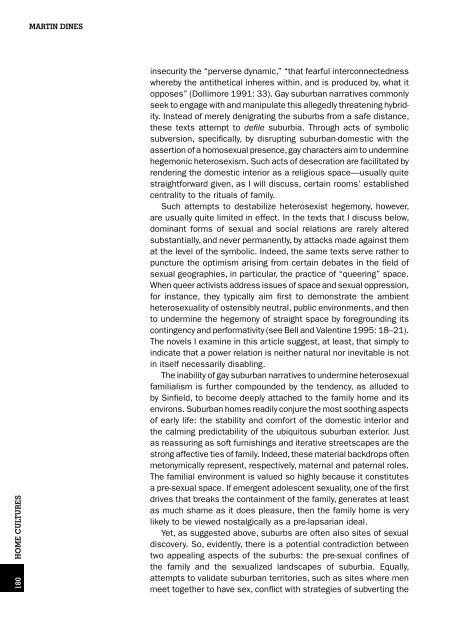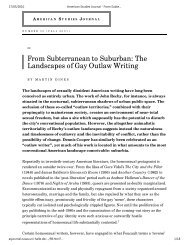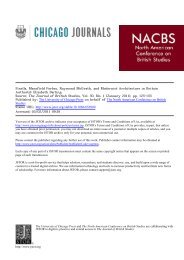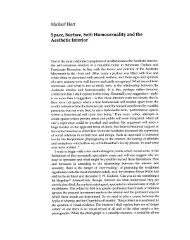sacrilege in the sitting room: contesting suburban ... - Fritz Haeg
sacrilege in the sitting room: contesting suburban ... - Fritz Haeg
sacrilege in the sitting room: contesting suburban ... - Fritz Haeg
You also want an ePaper? Increase the reach of your titles
YUMPU automatically turns print PDFs into web optimized ePapers that Google loves.
HOME CULTURES<br />
180<br />
MARTIN DINES<br />
<strong>in</strong>security <strong>the</strong> “perverse dynamic,” “that fearful <strong>in</strong>terconnectedness<br />
whereby <strong>the</strong> anti<strong>the</strong>tical <strong>in</strong>heres with<strong>in</strong>, and is produced by, what it<br />
opposes” (Dollimore 1991: 33). Gay <strong>suburban</strong> narratives commonly<br />
seek to engage with and manipulate this allegedly threaten<strong>in</strong>g hybridity.<br />
Instead of merely denigrat<strong>in</strong>g <strong>the</strong> suburbs from a safe distance,<br />
<strong>the</strong>se texts attempt to defile suburbia. Through acts of symbolic<br />
subversion, specifically, by disrupt<strong>in</strong>g <strong>suburban</strong>-domestic with <strong>the</strong><br />
assertion of a homosexual presence, gay characters aim to underm<strong>in</strong>e<br />
hegemonic heterosexism. Such acts of desecration are facilitated by<br />
render<strong>in</strong>g <strong>the</strong> domestic <strong>in</strong>terior as a religious space—usually quite<br />
straightforward given, as I will discuss, certa<strong>in</strong> <strong>room</strong>s’ established<br />
centrality to <strong>the</strong> rituals of family.<br />
Such attempts to destabilize heterosexist hegemony, however,<br />
are usually quite limited <strong>in</strong> effect. In <strong>the</strong> texts that I discuss below,<br />
dom<strong>in</strong>ant forms of sexual and social relations are rarely altered<br />
substantially, and never permanently, by attacks made aga<strong>in</strong>st <strong>the</strong>m<br />
at <strong>the</strong> level of <strong>the</strong> symbolic. Indeed, <strong>the</strong> same texts serve ra<strong>the</strong>r to<br />
puncture <strong>the</strong> optimism aris<strong>in</strong>g from certa<strong>in</strong> debates <strong>in</strong> <strong>the</strong> field of<br />
sexual geographies, <strong>in</strong> particular, <strong>the</strong> practice of “queer<strong>in</strong>g” space.<br />
When queer activists address issues of space and sexual oppression,<br />
for <strong>in</strong>stance, <strong>the</strong>y typically aim first to demonstrate <strong>the</strong> ambient<br />
heterosexuality of ostensibly neutral, public environments, and <strong>the</strong>n<br />
to underm<strong>in</strong>e <strong>the</strong> hegemony of straight space by foreground<strong>in</strong>g its<br />
cont<strong>in</strong>gency and performativity (see Bell and Valent<strong>in</strong>e 1995: 18–21).<br />
The novels I exam<strong>in</strong>e <strong>in</strong> this article suggest, at least, that simply to<br />
<strong>in</strong>dicate that a power relation is nei<strong>the</strong>r natural nor <strong>in</strong>evitable is not<br />
<strong>in</strong> itself necessarily disabl<strong>in</strong>g.<br />
The <strong>in</strong>ability of gay <strong>suburban</strong> narratives to underm<strong>in</strong>e heterosexual<br />
familialism is fur<strong>the</strong>r compounded by <strong>the</strong> tendency, as alluded to<br />
by S<strong>in</strong>field, to become deeply attached to <strong>the</strong> family home and its<br />
environs. Suburban homes readily conjure <strong>the</strong> most sooth<strong>in</strong>g aspects<br />
of early life: <strong>the</strong> stability and comfort of <strong>the</strong> domestic <strong>in</strong>terior and<br />
<strong>the</strong> calm<strong>in</strong>g predictability of <strong>the</strong> ubiquitous <strong>suburban</strong> exterior. Just<br />
as reassur<strong>in</strong>g as soft furnish<strong>in</strong>gs and iterative streetscapes are <strong>the</strong><br />
strong affective ties of family. Indeed, <strong>the</strong>se material backdrops often<br />
metonymically represent, respectively, maternal and paternal roles.<br />
The familial environment is valued so highly because it constitutes<br />
a pre-sexual space. If emergent adolescent sexuality, one of <strong>the</strong> first<br />
drives that breaks <strong>the</strong> conta<strong>in</strong>ment of <strong>the</strong> family, generates at least<br />
as much shame as it does pleasure, <strong>the</strong>n <strong>the</strong> family home is very<br />
likely to be viewed nostalgically as a pre-lapsarian ideal.<br />
Yet, as suggested above, suburbs are often also sites of sexual<br />
discovery. So, evidently, <strong>the</strong>re is a potential contradiction between<br />
two appeal<strong>in</strong>g aspects of <strong>the</strong> suburbs: <strong>the</strong> pre-sexual conf<strong>in</strong>es of<br />
<strong>the</strong> family and <strong>the</strong> sexualized landscapes of suburbia. Equally,<br />
attempts to validate <strong>suburban</strong> territories, such as sites where men<br />
meet toge<strong>the</strong>r to have sex, conflict with strategies of subvert<strong>in</strong>g <strong>the</strong>








